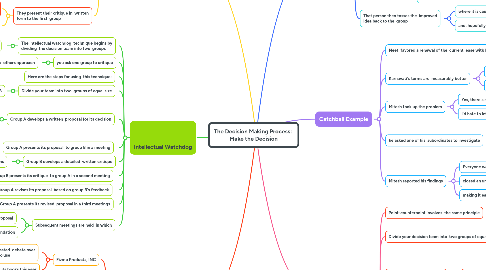
1. Intellectual Watchdog Example
1.1. A manufacturer of office furniture needs to improve the quality of its products
1.1.1. and two groups are assigned to work on the problem
1.2. The first group assumes that the company's quality problems stem
1.2.1. from outdated manufacturing equipment
1.3. its recommendation is an investment in computer-controlled equipment
1.4. It develops a written document that explains it
1.4.1. and includes a cost-benefit analysis of the $2 million investment
1.4.2. it believes necessary to cure the problem
1.5. Members of the second group question the assumptions
1.5.1. as well as the $2 million estimate
1.6. They present their critique in written form to the first group
1.6.1. the two groups work together in the revision-critique-revision cycle
1.6.2. until they arrive at a solution that both groups feel
1.6.2.1. will improve their products' quality
2. Intellectual Watchdog
2.1. The intellectual watchdog technique begins by dividing the decision team into two groups
2.1.1. But instead of asking each to develop a counter proposal
2.2. you ask one group to critique
2.2.1. and ask for improvement in the others approach
2.3. Here are the steps for using this technique:
2.4. Divide your team into two groups of equal size
2.4.1. group A and group B
2.5. Group A develops a written proposal for its decision
2.5.1. The proposal should include
2.5.1.1. recommendations
2.5.1.2. key assumptions
2.5.1.3. and supporting data
2.6. Group A presents its proposal to group B in a meeting
2.7. Group B develops a detailed written critique
2.7.1. of group A's assumptions and recommendations
2.8. Group B presents its critique to group A in a second meeting
2.9. Group A revises its proposal based on group B's feedback
2.10. Group A presents its revised proposal in a third meetings
2.11. Subsequent meetings are held in which
2.11.1. the two groups continue to critique and revise the proposal
2.11.2. until they agree on a recommendation
3. Point Counterpoint Example
3.1. Fizmo Products, INC
3.1.1. has been engaged in a heated debate over which accounting firm to use
3.1.2. to audit its books this year
3.2. One group favors one of the big-name national firms
3.2.1. whereas the other favors a smaller but well-respected local firm
3.3. The CFO tells his sub-ordinates
3.3.1. We need a decision that most people can live with
3.4. Using the point -counterpoint technique
3.4.1. the decision-making, team breaks into two groups
3.4.2. each containing supporters of the opposing views
3.5. One group develops a decision proposal
3.5.1. which the other considers and then returns
3.6. to the first group for evaluation and improvement
3.6.1. Eventually, they reach a conclusion that reflect the insights of all participants
4. Catchball
4.1. Catchball is one of many management methods developed in Japan
4.1.1. over the past several decades
4.2. It is a cross-Functional method for accomplishing two things:
4.2.1. improving ideas and encouraging buy-in among participants
4.3. Here's how it works
4.3.1. An initial idea is "tossed" to a collaborator for consideration
4.3.2. The idea might be a new marketing strategy
4.3.2.1. a new product, or a way to improve a work process
4.3.2.1.1. Catchball Figure
4.3.3. Whoever "catches" the idea assumes responsibility
4.3.3.1. for understanding it and improving it in some way
4.4. That person then tosses the improved idea back to the group
4.4.1. where it is caught by another person
4.4.2. and, hopefully, improved still further
5. Catchball Example
5.1. Neeti favored a renewal of the current lease with LeaselCo
5.1.1. There's a lot of merit in the idea of switching
5.1.2. from LeaselCo to Karnavati Motors
5.2. Karnavati's terms are measurably better
5.2.1. but we can't be sure of the quality of their maintenance
5.2.2. despite their contract terms and verbal assurances
5.3. Mitesh took up the problem
5.3.1. Yes, there's an uncertainty issue here
5.3.2. I'd hate to let $45,000 in annual savings slip through our fingers
5.4. he asked one of his subordinates to investigate
5.4.1. Get the names of ten or twelve companies that currently operate auto fleets leased from Karnavati
5.4.2. Then get on the phone and contact the person most involved in the deal
5.5. Mitesh reported his findings
5.5.1. Everyone was pleased with how the additional information
5.5.2. closed an uncertainty gap
5.5.3. making it easier to a reach a decision
6. Point counterpoint
6.1. Point-counterpoint involves the same principle
6.1.1. but involves two teams
6.2. Divide your decision team into two groups of equal size
6.2.1. group A and group B
6.2.2. Be sure to include supporters of opposing ideas in each group
6.3. Group A proposes a decision
6.3.1. Its written proposal should include
6.3.1.1. recommendations
6.3.1.2. key assumptions
6.3.1.3. and supporting data
6.4. Group A presents its proposal to group B in a meeting
6.5. Group B identifies one or more alternative courses of action
6.5.1. documenting its key assumptions and gathering supporting data
6.6. Group B presents its ideas to group A in a second meeting
6.7. In a third meeting
6.7.1. both groups debate the two proposals
6.7.2. and identify a common set of assumptions:
6.8. The ultimate goal is to get the whole group
6.8.1. to agree on a recommendation
